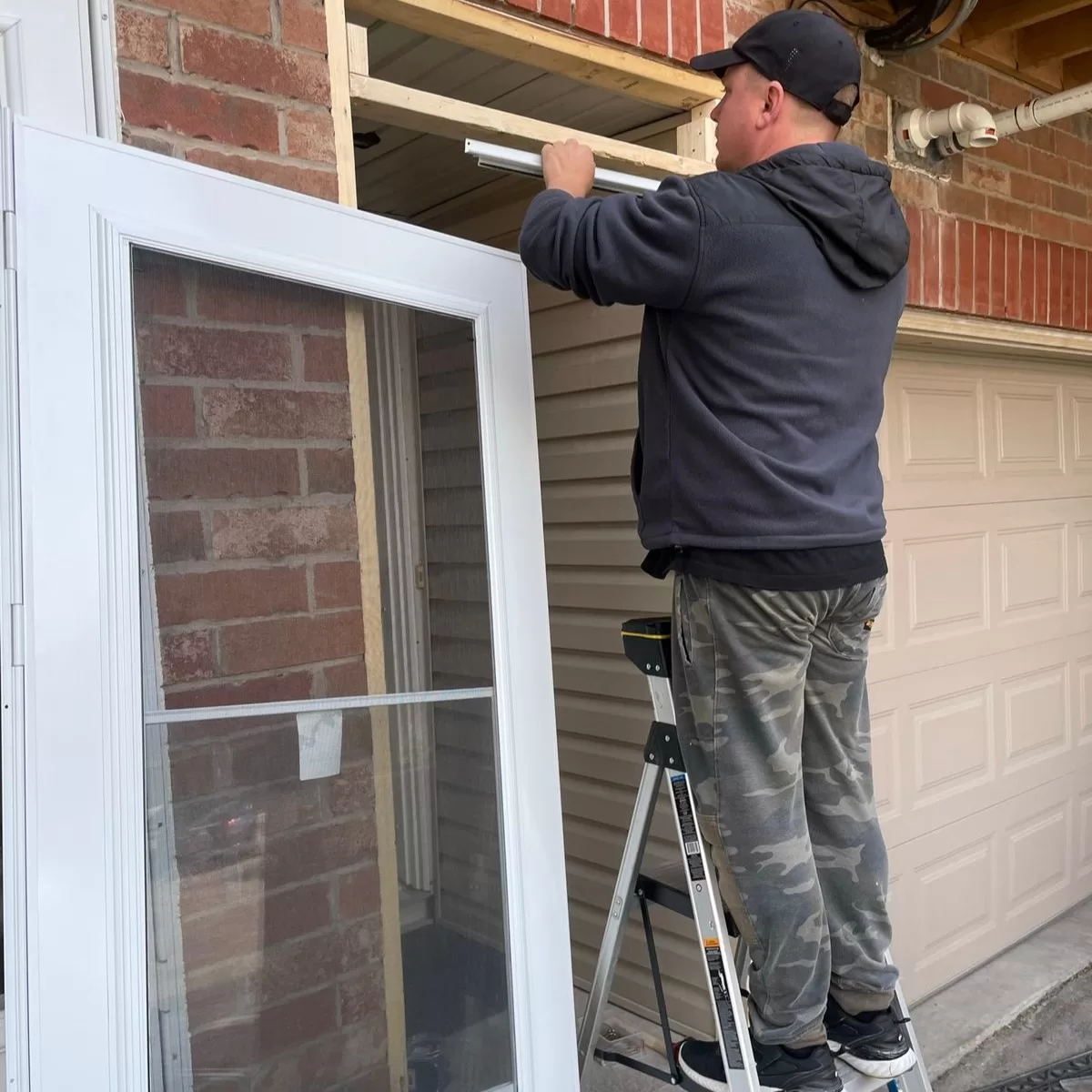Whether you’re giving your home a fresh look or replacing an old, worn-out door, installing a new door is an essential home improvement project. While it might seem like a daunting task at first, with the right tools and guidance, you can achieve professional results. This step-by-step guide will walk you through the process of installing a standard interior or exterior door, ensuring a proper fit and smooth operation.
1.Gather the Necessary Tools and Materials
Before you begin installing a door, make sure you have the following tools and materials on hand:
Tools:
- Measuring tape: Accurately measure the dimensions of the doorway and the new door.
- Screwdriver: Use a screwdriver that corresponds to the type of screws used for your door.
- Level: Ensure that the door is properly aligned and level during installation.
- Drill: Use a drill to create pilot holes and install screws.
- Hammer: Use a hammer to tap in any nails or secure components.
- Saw: If needed, use a saw to trim the door to fit the dimensions of the doorway.
Materials:
- New door and frame: Choose a door that fits the dimensions of the doorway and matches your desired style.
- 16d galvanized nails: Essential for securing the door frame to the wall structure.
- 3-in. Screws: For attaching hinges and securing the door in place.
- Door latch and lock: Ensure security and proper closure of the door.
- Minimal expanding foam: Used for insulating and sealing the gaps around the door frame.
- Polyurethane caulk: Ideal for sealing joints and preventing air leaks.
- Wood shims: These small wedges help ensure the door is plumb and level.
With this comprehensive list, you’ll be fully prepared to tackle your door installation project, ensuring you have all the necessary components to achieve professional results.
How to Measure an Old Door and Order a New One
Replacing a door might seem daunting, but with the right measurements, you can ensure a perfect fit without expensive modifications. Follow these steps to measure your old door and order a new one with confidence.
1. Measure the Existing Door:
Begin by measuring the width and height of the current door. This provides a baseline for your new door size. Once you have these measurements, it’s essential to understand how to measure a door accurately to ensure a proper fit for your replacement. Be sure to take measurements at multiple points, as older doors may be warped or misaligned. This thorough approach will help you avoid potential issues during installation.
2. Determine the Rough Opening:
Carefully remove the interior trim to expose the rough opening. Measure the width between the wall studs and the height from the floor to the top header. These dimensions are crucial for ensuring that the new door fits snugly.
3. Check Jamb Width:
Measure from the back of the exterior trim (often called brick molding) to the face of your interior wall. This measurement determines the jamb width. Ordering a door with the correct jamb width ensures your interior trim will fit seamlessly, eliminating the need for additional jamb extensions.
4. Evaluate the Exterior Measurements:
Head outside and measure from the outer edge of the brick molding across the width, and from the bottom of the sill to the top of the exterior trim for the height. Always opt for a door assembly that fills this space to avoid any siding patchwork. Sometimes, opting for wider exterior trim, beyond the standard 2-inch brick molding, might be necessary to cover gaps.
5. Consider Sidelights and Adjustments:
If your door includes sidelights, determine how they affect the overall width. Adjust the width by selecting different sized sidelights or by tweaking the space between the door and sidelights. Many suppliers provide the option to assemble doors and sidelights at the factory, simplifying the installation process.
6. Finalize and Shop for Your Door:
With all these measurements, compare them with standard door configurations. If the commonly available sizes don’t match, you might need adjustments. For example, adding spacers between doors and sidelights can solve width discrepancies. If height differences exist, consider filling gaps later with trim or raising the door slightly.
By following this methodical approach, you’ll be well-prepared to pick the perfect door that complements your home’s design without costly customizations.
2.Remove the Old Door (if applicable)
If you’re replacing an existing door, start by removing the old door and frame. Follow these steps:
- Remove the hinge pins: Using a screwdriver or hammer and nail, tap out the hinge pins to detach the old door from the frame.
- Take out the screws: Unscrew the hinges and remove any screws securing the frame to the doorway.
- Gently pry off the frame: Carefully pry off the old door frame using a pry bar or flathead screwdriver. Take caution to avoid damaging the surrounding walls.
- Prepare to cut: Equip yourself with a reciprocating saw for the next step. This tool will make the process smoother by allowing you to efficiently cut through the nails securing the frame.
- Cut through the nails: Position the blade of the reciprocating saw at the nail points. With steady hands, cut through each nail to loosen the frame from its position. This precise action ensures the frame can be removed without unnecessary force.
- Safely remove the frame: Once all the nails have been cut, the door frame should come free with minimal effort. Handle the frame carefully to prevent injury or damage to adjacent structures.
Tip: Use a putty knife under the pry bar to protect wall paint and avoid unnecessary repairs.
3.Prepare the Doorway
Once the old door and frame are removed, prepare the doorway for the installation of the new door:
- Clean the doorway: Remove any debris, dirt, or old caulk from the doorway to ensure a clean surface for installation.
- Measure the doorway: Use a measuring tape to determine the dimensions of the doorway, including the height, width, and depth.
Considerations:
- Check if the subfloor is level. If not, you may need to add a strip of plywood or shims to correct any unevenness.
- Ensure there’s no water damage to the sill area, especially if the door is exposed to the weather.
4.Install the New Door
Now it’s time to install the new door:
- Place the door in the opening: Carefully lift the new door and place it in the doorway, ensuring it fits snugly.
- Insert shims: Insert shims between the door frame and the doorway to create a level and plumb installation. Adjust the shims as needed until the door is properly aligned.
- Secure the door frame: Use screws to secure the door frame to the doorway, making sure to drive them into the shims for stability.
- Check for proper alignment: Use a level to ensure the door is plumb and level. Adjust the shims and frame as necessary.
- Install the hinges: Attach the hinges to the door frame using screws, ensuring they are properly aligned with the corresponding hinge cutouts on the door.
- Attach the doorknob and hardware: Install the doorknob, lockset, and any additional hardware according to the manufacturer’s instructions.
Pro Tip: Use polyurethane caulk to seal the sill and around the perimeter of the opening to provide extra protection against drafts.
5.Test and Make Adjustments
After installing the door, perform the following checks:
- Test the door swing: Open and close the door to ensure it swings smoothly and without any obstructions.
- Check for proper alignment: Use a level to verify that the door is still plumb and level after installation. Make any necessary adjustments to the shims or hinges.
Note: Shimming is a critical step; spend time adjusting to ensure an even gap around the door for smooth operation.
6.Finish and Seal
To complete the door installation, follow these final steps:
- Trim excess shims: Using a utility knife or saw, carefully trim any excess shims that extend beyond the door frame.
- Fill gaps and holes: Fill any gaps or holes around the door frame with caulk or wood filler to create a seamless appearance and enhance insulation. To ensure a snug fit, begin by sealing the space between the jamb and the framing with expanding foam. This method effectively insulates and stabilizes the door, preventing drafts and energy loss. When applying the foam, be cautious not to overfill, as too much can cause the foam to expand excessively and create pressure on the door frame. If you’re new to using spray foam, start with small amounts and gradually build up to avoid any mishaps. Once the foam has set, trim any excess with a utility knife for a clean finish. After the foam has cured and the shim space is well-sealed, move to the exterior. Install a piece of trim over the door and apply caulk around the edges to seal the exterior thoroughly. This step not only protects against weather but also enhances the overall aesthetic of the door installation. Finally, address the interior by installing new trim around the door frame and finish off by fitting the new handle and lock. This comprehensive approach ensures your door is both functional and visually appealing, while providing optimal insulation and security.
- Paint or stain the door: If desired, apply a coat of paint or stain to the door and frame to match your interior or exterior decor.
- Install weatherstripping: Attach weatherstripping along the door frame to improve energy efficiency and prevent drafts.
7.Regular Maintenance
To ensure the longevity and optimal performance of your newly installed door, consider the following maintenance tips:
- Clean and lubricate hinges: Periodically clean the hinges and apply lubricant to ensure smooth operation.
- Inspect and repair any damage: Regularly inspect the door for signs of wear, such as cracks or warping, and promptly address any issues to maintain its functionality and security.
- Adjust hardware: Over time, the door may require adjustments to the hardware, such as tightening screws or aligning the strike plate, to ensure proper functioning.
Conclusion
Installing a door can be a rewarding project that enhances both the functionality and aesthetic appeal of your home. By following this step-by-step guide, you can confidently tackle the installation process and enjoy the benefits of a well-installed door. Remember to gather the necessary tools, measure accurately, and take your time to ensure proper alignment and stability. If you encounter any challenges or are unsure about any step, it’s always recommended to consult a professional for assistance.
At Enlive Doors, we strive to provide you with valuable information and resources to help you with your home improvement projects. Remember, when installing a new door, it’s always best to rely on the expertise of professionals like Enlive Doors to ensure a safe and efficient installation, contact us today!



